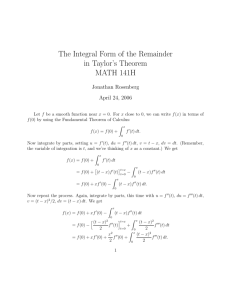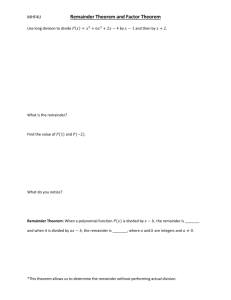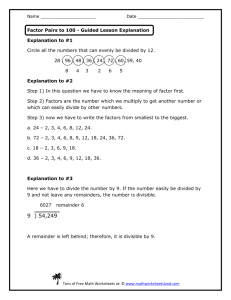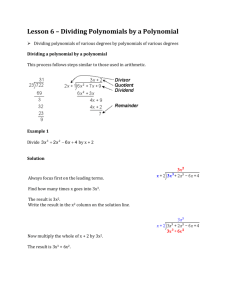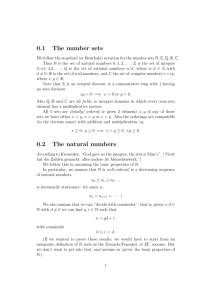Intermediate Algebra: Remainder Theorem & Polynomial Division
advertisement
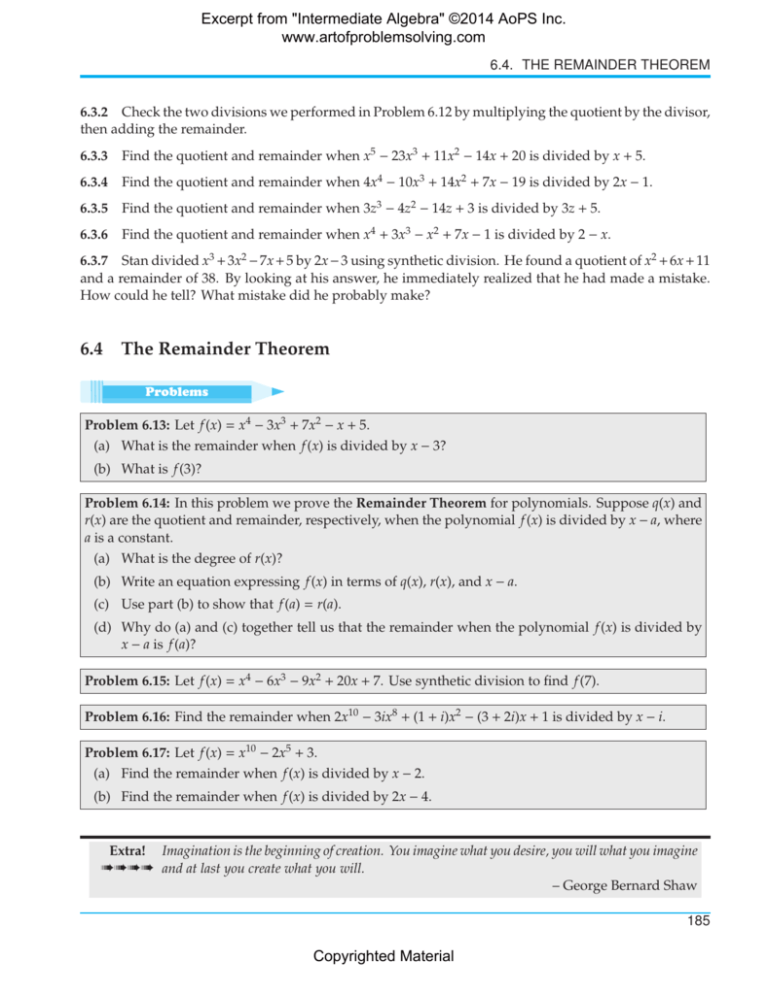
Excerpt from "Intermediate Algebra" ©2014 AoPS Inc. www.artofproblemsolving.com 6.4. THE REMAINDER THEOREM 6.3.2 Check the two divisions we performed in Problem 6.12 by multiplying the quotient by the divisor, then adding the remainder. 6.3.3 Find the quotient and remainder when x5 6.3.4 Find the quotient and remainder when 4x4 6.3.5 Find the quotient and remainder when 3z3 23x3 + 11x2 14x + 20 is divided by x + 5. 10x3 + 14x2 + 7x 4z2 19 is divided by 2x 1. 14z + 3 is divided by 3z + 5. 6.3.6 Find the quotient and remainder when x4 + 3x3 x2 + 7x 1 is divided by 2 x. 6.3.7 Stan divided x3 + 3x2 7x + 5 by 2x 3 using synthetic division. He found a quotient of x2 + 6x + 11 and a remainder of 38. By looking at his answer, he immediately realized that he had made a mistake. How could he tell? What mistake did he probably make? 6.4 The Remainder Theorem Problems Problem 6.13: Let f (x) = x4 3x3 + 7x2 x + 5. (a) What is the remainder when f (x) is divided by x 3? (b) What is f (3)? Problem 6.14: In this problem we prove the Remainder Theorem for polynomials. Suppose q(x) and r(x) are the quotient and remainder, respectively, when the polynomial f (x) is divided by x a, where a is a constant. (a) What is the degree of r(x)? (b) Write an equation expressing f (x) in terms of q(x), r(x), and x a. (c) Use part (b) to show that f (a) = r(a). (d) Why do (a) and (c) together tell us that the remainder when the polynomial f (x) is divided by x a is f (a)? Problem 6.15: Let f (x) = x4 6x3 9x2 + 20x + 7. Use synthetic division to find f (7). Problem 6.16: Find the remainder when 2x10 Problem 6.17: Let f (x) = x10 3ix8 + (1 + i)x2 (3 + 2i)x + 1 is divided by x i. 2x5 + 3. (a) Find the remainder when f (x) is divided by x (b) Find the remainder when f (x) is divided by 2x 2. 4. Imagination is the beginning of creation. You imagine what you desire, you will what you imagine ‡‡‡‡ and at last you create what you will. – George Bernard Shaw Extra! 185 Copyrighted Material Excerpt from "Intermediate Algebra" ©2014 AoPS Inc. www.artofproblemsolving.com CHAPTER 6. POLYNOMIAL DIVISION Problem 6.18: Let P(x) be a polynomial such that when P(x) is divided by x 19, the remainder is 99, and when P(x) is divided by x 99, the remainder is 19. In this problem we find the remainder when P(x) is divided by (x 19)(x 99). (Source: AHSME) (a) Find P(19) and P(99). (b) Let r(x) be the desired remainder. Write an equation representing the division of P(x) by (x 19)(x 99). (c) What is the degree of r(x)? (d) Choose two convenient values of x and substitute these into your equation from (b). Use the results to find r(x). Problem 6.19: Find the remainder when the polynomial x81 + x49 + x25 + x9 + x is divided by x3 (Source: Great Britain) Problem 6.13: Let f (x) = x4 3x3 + 7x2 x. x + 5. (a) What is the remainder when f (x) is divided by x 3? (b) What is f (3)? Solution for Problem 6.13: (a) We find the remainder using the synthetic division shown at right. The remainder is 65. (b) We have f (3) = 34 2 3 · 33 + 7 · 32 3 3 + 5 = 65. Hmm. . . . We see that f (3) equals the remainder when f (x) is divided by x 1 1 3 3 0 7 0 7 1 21 20 5 60 65 3. Is this a coincidence? Problem 6.14: Suppose q(x) and r(x) are the quotient and remainder, respectively, when the polynomial f (x) is divided by x a, where a is a constant. Is it always true that the remainder equals f (a)? Solution for Problem 6.14: Because q(x) and r(x) are the quotient and remainder, respectively, when the polynomial f (x) is divided by x a, we have f (x) = (x a)q(x) + r(x). Because either the remainder is 0 or its degree is less than the degree of the divisor x must be a constant. So, we let r(x) = c for some constant c, and we have f (x) = (x a, we see that r(x) a)q(x) + c. This equation must hold for all x, and we’re interested in f (a), so we let x = a in the equation. This gives f (a) = (a a)q(a) + c = 0 · q(a) + c = c. Therefore, when a polynomial f (x) is divided by x a, the remainder is f (a). 2 186 Copyrighted Material Excerpt from "Intermediate Algebra" ©2014 AoPS Inc. www.artofproblemsolving.com 6.4. THE REMAINDER THEOREM Important: The Remainder Theorem states that when a polynomial f (x) is divided by x a, the remainder is f (a). Problem 6.15: Let f (x) = x4 6x3 9x2 + 20x + 7. Use synthetic division to find f (7). Solution for Problem 6.15: We can put x = 7 into f (x) to evaluate 7 1 6 f (7), but the Remainder Theorem allows us to evaluate f (7) with less 7 complicated arithmetic. The synthetic division at right tells us that 1 1 the remainder when f (x) is divided by x 7 is 49. Therefore, we have f (7) = 49. 2 9 7 2 20 14 6 7 42 49 The Remainder Theorem can also be used to find remainders without division. Problem 6.16: Find the remainder when 2x10 3ix8 + (1 + i)x2 (3 + 2i)x + 1 is divided by x i. Solution for Problem 6.16: We could use synthetic division, even though some of our coefficients are nonreal. However, because we’re dividing a 10th degree polynomial, this synthetic division would be pretty lengthy. Instead, we use the Remainder Theorem. We let f (x) = 2x10 3ix8 + (1 + i)x2 (3 + 2i)x + 1. By the Remainder Theorem, the remainder when we divide f (x) by x i is f (i) = 2 · i10 = 2( 1) 3i · i8 + (1 + i) · i2 3i(1) + (1 + i)( 1) (3 + 2i) · i + 1 3i 2i2 + 1 = 7i. 2 Problem 6.17: Let f (x) = x10 2x5 + 3. Find the remainder when f (x) is divided by 2x 4. Solution for Problem 6.17: What’s wrong with this solution: Bogus Solution: The remainder is f (4) = 410 2 · 45 + 3 = 1046531. The Remainder Theorem tells us that when f (x) is divided by x a, the remainder is f (a). The value of f (4) equals the remainder when f (x) is divided by x 4, not 2x 4. WARNING!! j The Remainder Theorem applies to division by linear expressions with leading coefficient 1. While we can’t directly apply the Remainder Theorem, we can use our proof of the Remainder Theorem as guidance. Because we are dividing by a linear expression, the remainder must be a constant. So, we seek the constant r such that f (x) = (2x 4)q(x) + r 187 Copyrighted Material Excerpt from "Intermediate Algebra" ©2014 AoPS Inc. www.artofproblemsolving.com CHAPTER 6. POLYNOMIAL DIVISION for all values of x. When proving the Remainder Theorem, we eliminated q(x) by setting x equal to a value that made the divisor 0. Here, we let x = 2 to find f (2) = (2 · 2 4)q(2) + r = r. So, our remainder is f (2) = 210 2 · 25 + 3 = 963. 2 Notice that the key step in this solution is not to apply the Remainder Theorem directly, but rather to use the same general technique we used to prove the Remainder Theorem. Concept: Don’t just memorize important theorems. Learn how to prove them. The methods used to prove important theorems can also be used to solve other problems to which it is not easy to directly apply these theorems. Here, the technique we use is: Concept: Suppose q(x) and r(x) are the quotient and remainder, respectively, when the polynomial f (x) is divided by the polynomial d(x). One powerful way to learn more about r(x) is to express the division as f (x) = q(x) · d(x) + r(x), and then eliminate the q(x) · d(x) term by choosing values of x such that d(x) = 0. Combining this with the fact that deg r is no greater than deg d will often allow us to determine r(x). This strategy works even when d(x) is not linear. Problem 6.18: Let P(x) be a polynomial such that when P(x) is divided by x 19, the remainder is 99, and when P(x) is divided by x 99, the remainder is 19. What is the remainder when P(x) is divided by (x 19)(x 99)? (Source: AHSME) Solution for Problem 6.18: Because we are dividing by a quadratic, the degree of the remainder is no greater than 1. So, the remainder is ax + b, for some constants a and b. Therefore, we have P(x) = (x 19)(x 99)Q(x) + ax + b, where Q(x) is the quotient when P(x) is divided by (x 19)(x 99). We can eliminate the Q(x) term by letting x = 19 or by letting x = 99. Doing each in turn gives us the system of equations P(19) = 19a + b = 99, P(99) = 99a + b = 19. Solving this system of equations gives us a = 1 and b = 118. So, the remainder is x + 118. 2 Problem 6.19: Find the remainder when the polynomial x81 + x49 + x25 + x9 + x is divided by x3 (Source: Great Britain) x. Solution for Problem 6.19: Let P(x) = x81 + x49 + x25 + x9 + x and let Q(x) be the quotient when P(x) is divided by x3 x. We are dividing by a cubic, so the degree of the remainder is no more than 2. 188 Copyrighted Material Excerpt from "Intermediate Algebra" ©2014 AoPS Inc. www.artofproblemsolving.com 6.5. SUMMARY Therefore, the remainder is ax2 + bx + c for some constants a, b, and c. So, we have P(x) = (x3 x)Q(x) + ax2 + bx + c. Since x3 x = x(x + 1)(x 1), we can let x = 1, 0, or 1 to make x3 us the system of equations P( 1) = a x equal to 0. Doing each in turn gives b + c, P(0) = c, P(1) = a + b + c. Since P(0) = 0, we have c = 0. Adding the first and third equations then gives 2a = P( 1) + P(1) = 5 + 5 = 0, so a = 0. Finally, from P(1) = a + b + c, we have b = P(1) = 5, so the desired remainder is 5x. 2 Exercises Let g(x) = 2x6 6.4.1 x4 + 4x2 8. Find the remainder when g(x) is divided by each of the following: (a) x+1 (c) x+3 (e) x2 + 4x + 3 (b) x 1 (d) x 3 (f) x2 4x + 3 6.4.2 When y2 + my+ 2 is divided by y 1, the quotient is f (y) and the remainder is R1 . When y2 + my + 2 is divided by y+1, the quotient is g(y) and the remainder is R2 . If R1 = R2 , then find m. (Source: AHSME) 6.4.3 Find the remainder when x100 is divided by (x constants in the form ab in your answer.) 1)(x 2). (Source: AHSME) (You can leave 6.4.4 Suppose q(x) and r(x) are the quotient and remainder, respectively, when the polynomial f (x) is divided by the polynomial d(x). Show that if x = a is a root of d(x), then r(a) = f (a). 6.4.5? 6.5 Find the remainder when x100 4x98 + 5x + 6 is divided by x3 2x2 x + 2. Hints: 91 Summary A polynomial in one variable is an expression or function of the form an xn + an 1 xn 1 + an 2 xn 2 + · · · + a1 x + a 0 , where x is a variable and each ai is a constant. Each individual summand ai xi is called a term, and each number ai is the coefficient of the corresponding xi . The degree of a polynomial is the greatest integer n such that the coefficient an is not equal to 0. (The degree of the polynomial 0 is undefined.) Important: When the polynomial f (x) is divided by the polynomial d(x), the quotient q(x) and remainder r(x) are the polynomials such that f (x) = q(x) · d(x) + r(x) and either r(x) = 0 or deg r < deg d. 189 Copyrighted Material
